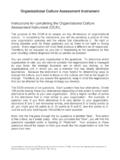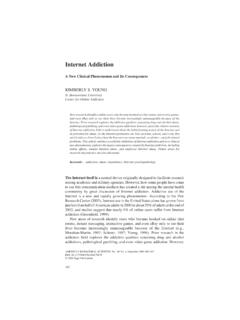Transcription of THE NATURE OF COMMUNICATION IN …
1 Organizational COMMUNICATION for Survival: Making Work, Work. Richmond, McCroskey, & McCroskey (2005). THE NATURE OF COMMUNICATION IN ORGANIZATIONS Regardless of the type of organization , COMMUNICATION is the element that maintains and sustains relationships in it. What person A says to person B not only can have an impact on those two people but, since organizations are systems, it also can have a meaningful impact on the total system. Your COMMUNICATION with your co-workers and supervisors in the organization will be a major determinant of how satisfied you are with your work, and how satisfied others are with your work. For example, in one organization where we worked, there was a very gossipy, control-oriented person who would subtly let others know what he/she thought of his/her co-workers.
2 Eventually, this type of COMMUNICATION made it impossible for others to work with this individual. When asked to work with this person, others would find excuses not to or would become "ill" when the time to do the work rolled around. This, of course, had a negative impact on the work of the total unit. The COMMUNICATION behavior of individual employees plays a more significant role in organizational life than some think. Organizational COMMUNICATION is central to organization success. MYTHS AND MISCONCEPTIONS ABOUT COMMUNICATION IN ORGANIZATIONS Only a small proportion of the people in most organizations have ever engaged in serious study of how the process of COMMUNICATION works. COMMUNICATION is one of those things we deal with every day, so most of us assume we know quite a bit about it.
3 Although that assumption often is correct, most of us also know some things about COMMUNICATION because they are just "common sense." Unfortunately, some things that are "common sense" are just plain wrong. Before we turn our attention to some of the basic facts about COMMUNICATION in organizations, and some advice on how to deal with those realities, we need to look at some of the most common 16 THE NATURE OF COMMUNICATION IN ORGANIZATIONS 17 misconceptions about COMMUNICATION in organizations so we do not fall prey to these myths as we strive to survive. Myth 1: Meanings are in words. The idea that meanings are in words is perhaps the most common misconception about COMMUNICATION . This misconception can lead to much misunderstanding between two people and thwart the effectiveness of COMMUNICATION between supervisor and subordinate.
4 What a particular word means to us may not be what it means to someone else. The word stimulates a meaning in our minds that is different from the meaning it stimulates in the mind of our colleague. For example, the word evaluation carries different meanings for people at different levels in the organization . The lower-level employees might feel this means the end of them. The upper-level management might feel this means support for their work. The point we wish to make about words and their meanings is that no word has meaning apart from the person using it. No two people share precisely the same meanings for all words. Meanings are in people, not words. Therefore/ we must realize that what we say to others in the organi-zation might not stimulate in their minds the meaning we want or intend to be stimulated.
5 This requires that we adapt our ideas to the background and experiences of our colleagues so that they can adapt to our ideas. Myth 2: COMMUNICATION is a verbal process. When most people, whether they are top management or have just taken an entry-level position, think about COMMUNICATION , they think chiefly about words written or spoken. They rarely focus on the relevance of the nonverbal aspect of COMMUNICATION . Yet much of COMMUNICATION is nonverbal. In fact, when we talk to someone, our verbal COMMUNICATION is always accompanied by nonverbal messages as well. How we say something is as important as what we say, and often more important. How we act is as important as what we say, and often more important. Nonverbal actions often contradict verbal messages, and when they do most people believe the nonverbal over the verbal.
6 Thus, the process a/ COMMUNICATION is both verbal and nonverbal, Myth 3: Telling is communicating. Many employees and managers feel that if they have "said it to her" or "told him about it," they have communicated. They may have tried to communicate, but that is no guarantee they have communicated. It is very naive to think that this is all there is to COMMUNICATION . Telling is only part of COMMUNICATION often a small part. People who believe that telling people something is equal to communicating with them fail to acknowledge the active role of receivers. Sources have to consider what meaning a receiver might attach to the message, what a receiver's background is, what a receiver thinks and feels. If anything, telling is only half of communicating.
7 To be effective communicators, we have to be sensitive to the other person's views and COMMUNICATION skills. If your 18 CHAPTER TWO boss makes this mistake/ you can be assured you will be blamed for the boss's mistake. Consequently, you must take an active role in communicating with your supervisor to be certain you fully understand anything you are told. Although it is not fair to hold you responsible for inadequate COMMUNICATION on the part of the boss/ that is the reality with which you must be prepared to deal. Myth 4: COMMUNICATION will solve all our problems. For years, people have tried to convince us that COMMUNICATION will solve all our problems. If the wife and the husband are not getting along, get them to sit down and talk it out that will solve the problem.
8 If the parent and the child are not getting along, get them to sit down and talk it out that will solve the problem. If the supervisor and the subordinate cannot get along, get them to sit down and talk it out that will solve the problem. Unfortunately, it just is not so. COMMUNICATION can either create or help overcome problems. Remember, there are a lot of ineffective communicators out there, and often they create more problems than they solve by not knowing how to use COMMUNICATION . There are some situations where COMMUNICATION should be decreased, not increased, such as in true conflict situations. The parties should be separated, not forced to communicate. Yet in many organizations, some individuals always think COMMUNICATION can solve problems, so they put two people or two groups together who hate each other.
9 They force them to communicate and cannot understand why matters only get worse. Effective organizational COMMUNICATION may allow us to solve some problems, but it cannot be expected to solve all problems. COMMUNICATION is no magic elixir. It will not cure cancer, it will not overcome weight problems, and it will not solve all the problems in an organization . But we can, by communicating more effectively, avoid making some things worse. Myth 5: COMMUNICATION is a good thing. Ask 10 people you encounter at work today, "Is COMMUNICATION a good thing?" Probably over half, maybe all 10, will look at you a bit strangely and answer "Certainly," or words to that effect. Since, as we noted above, many people think COMMUNICATION will solve all our problems, it is reasonable they would also think of com-munication as "good.
10 " In reality, COMMUNICATION is neither a good nor a bad thing. COMMUNICATION is a tool, and like any tool, COMMUNICATION can be used for good or bad purposes. The way a person uses COMMUNICATION determines its goodness or badness. For example, take a computer. If we use this tool for its intended purpose to process information we can say that it is a good and useful device. Put that computer in the hands of an irate employee and he or she can use it to destroy data and information. Is the computer bad? No, it is simply being used in a bad way. It is the same for COMMUNICATION . We can use our COMMUNICATION for good or evil purposes. THE NATURE OF COMMUNICATION IN ORGANIZATIONS 19 Hopefully, this book will suggest ways in which to use COMMUNICATION as a positive tool to enhance our work environment and our work relationships.















